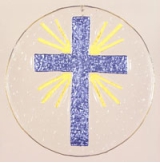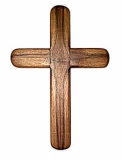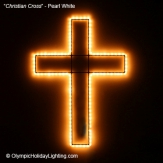The cross symbol has been a vital influence in the worship and lives of Christians. Here are seven historical forms of the cross explained and interpreted for today. Each page includes the history of the particular cross, a meaningful devotion and suggested daily reading for personal meditation. The sign of the cross series can serve as the basis for Lenten devotions, sermons, worship, or study.
Latin Cross – Suffering
The Sign of the Cross
"But we do see... Jesus, because of the suffering of death crowned with glory and honor, that by the grace of God He might taste death for everyone." - Hebrews 2:9The all too familiar picture of Jesus suffering in agony on the cross humbles us. This tragic perspective over Golgotha engages us again with the mystery of death and the meaning of the passion. Indeed, it is a yoke our Lord took upon Himself, a burden of sin, rejections, and ridicule which he accepted obediently. Even though the crucifixion occurred almost 2000 years ago, it was for such a time as ours that Christ lived and died. In effect the cross was an altar upon which the once-for-all sacrifice for humankind was offered to God, reconciling our world to our Divine Parent. As a symbol it still has the potent power to transform the world because we who live today still share in the life that was given on it.
“Whosoever will come after me, let him deny himself, take up his cross and follow me.” (Mark 8:34)By his own words Jesus expected, warned and invited his followers to take up similar crosses because of the hatred in the world. “He was a man like us,” wrote one contemporary pastor, “but we are not sure that we can be men like Him.” Commitment has a heavy price and we are understandably reluctant to pay it. Happily, God, in His grace, has already accomplished it for all of us.
LATIN CROSS
 Of all the infinite Variations the cross has assumed ,the Latin Gross, formed by a long upright stake with a transverse bar placed a short distance from the top, is the most commonly used and popularly accepted form. Some contend that the Tau or T-shaped Cross most accurately reproduces the form probably used as a particularly cruel method of actually putting criminals to death by suffocation but there is not unanimous support. Those authorities who argue for the Latin form contend the Tau Cross offered no place to put Pilate’s inscription mentioned in the scriptures.
Of all the infinite Variations the cross has assumed ,the Latin Gross, formed by a long upright stake with a transverse bar placed a short distance from the top, is the most commonly used and popularly accepted form. Some contend that the Tau or T-shaped Cross most accurately reproduces the form probably used as a particularly cruel method of actually putting criminals to death by suffocation but there is not unanimous support. Those authorities who argue for the Latin form contend the Tau Cross offered no place to put Pilate’s inscription mentioned in the scriptures.
The Greek Cross with equilateral transepts was also used by the early church and eventually adopted by the Eastern Orthodox churches. The Latin Cross receive its name because after the separation of church completed in A.D.1054, it was associated with the Western churches.
The lengthened standard of the Latin Cross may have been derived from the staff of processional crosses. It resembles the standard surmounted by a cross carried by Christ in early carvings. This expression probably gave rise to the custom of depicting Christ raised on a high cross in representations of the Crucifixion.
Passion and Suffering
The design of the Latin Cross is also known as the Passion Cross. Even though it is usually identified with Western Christendom and especially the Roman Catholic Church, the Passion Cross was also used in Byzantine churches from the fourth century of Constantine the Great through the sixth century of the Emperor Justinian, who built Hagia Sophia (“Holy Wisdom”), a major Eastern church in Istanbul in which the Latin Cross was used.
 Hellenistic artists influenced by Greek culture preferred the beauty of the old square Greek Cross with its equal limbs. These same Eastern artists recoiled from the cruelty suggested by the Latin Cross and preferred to indicate the sacrifice of our Lord by a simple decorated square cross rather than an agonizing crucified figure usually pictured on the Passion Cross.
Hellenistic artists influenced by Greek culture preferred the beauty of the old square Greek Cross with its equal limbs. These same Eastern artists recoiled from the cruelty suggested by the Latin Cross and preferred to indicate the sacrifice of our Lord by a simple decorated square cross rather than an agonizing crucified figure usually pictured on the Passion Cross.
Joan of Arc, bound to a stake, with the crackling flames all about her, begged for a cross. A sympathetic soldier fashioned two small sticks of wood together and with this crude semblance of a gibbet in her hand and a prayer on her lips, Joan of Arc died. To her it was not the emblem of her faith, but the assurance of her soul's salvation.
Meditation and Further Reflection
O Lord, it is difficult for us in the midst of our modern and intensely materialistic culture to realize how vit6al and widespread the influence of the cross has been all through the centuries. Indeed, the safety of our own time, far removed from the martyrdoms of the early saints and your own death, make it hard for us to comprehend the the pain, discrimination, and tragedy experiences by the faithful.
Help us to regard the cross as more than an interesting ornament or cherished artifact. Stab us with the reality of its tortuous and humiliating function. Than we may appreciate the Christian significance and persecution which established it in our sacred tradition.
 Also, O Lord, bless us by helping us to see beyond the cross to the hope of new life and the promise of resurrection which it represents. However mystifying and conflicting may be the meanings of ancient crosses, let the revelation of what you accomplished on the tree ever remain in our awareness. For it is a sign of ultimate mercy, grace, and forgiveness which has the eternal power to save us.
Also, O Lord, bless us by helping us to see beyond the cross to the hope of new life and the promise of resurrection which it represents. However mystifying and conflicting may be the meanings of ancient crosses, let the revelation of what you accomplished on the tree ever remain in our awareness. For it is a sign of ultimate mercy, grace, and forgiveness which has the eternal power to save us.
Finally, O Lord, whatever disgrace or cruel mockery you may have suffered on the cross of Calvary have been more than vindicated by God's final word of new life and victory. Therefore, we rejoice, not forgetting the cost of discipleship, remembering the limits to which you have gone to redeem us. Amen.
Readings:
- Sunday - Luke 19:1-48
- Monday - Matthew 21:12-46
- Tuesday - John 14:1-16:31
- Wednesday - Luke 21:1-38
- Thursday - Mark 14:1-72
- Friday - John 17:1-26
Hear the Message
© 2012, Dr. Neal Carlson. All Rights Reserved.
 Tau – Repentance
Tau – Repentance Maltese – Protection
Maltese – Protection Jerusalem – Healing
Jerusalem – Healing Anchor – Hope
Anchor – Hope Celtic – Mission
Celtic – Mission Latin – Suffering
Latin – Suffering Cross & Orb – Victory
Cross & Orb – Victory